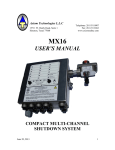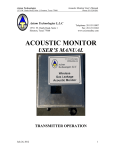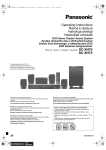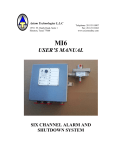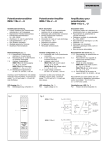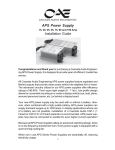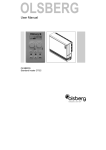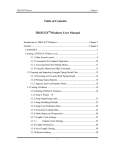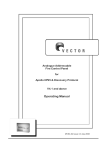Download USER`S MANUAL - Axiom Technologies, LLC
Transcript
Axiom Technologies L.L.C 15711 W. Hardy Road, Suite 1 Houston, Texas 77060 Telephone: 281 931 0907 Fax: 281 231 6562 www.axiomsafety.com MX16 USER’S MANUAL COMPACT MULTI-CHANNEL SHUTDOWN SYSTEM February 20, 2015 1 Axiom Technologies 15711 W. Hardy Road, Suite 1, Houston, Texas 77060 MX16 User’s Manual Phone 281 931 0907 GENERAL The MX16 alarm and shutdown system is a self supported, compact shutdown device that has been designed to provide a safe and reliable means to detect abnormal conditions on a production process and initiate a shutdown if any of the reading show the operation is no longer within the pre-set safety margins. The system has been built to withstand the adverse conditions of the oil-field environment and provides a straightforward interface with the operator. Abnormal conditions are indicated by indicator lamps (LEDs), each associated with a front panel label indicating the condition detected. Powered by lithium batteries, the system is expected to operate for about three years without replacing batteries, and there is little or no maintenance needed besides recommended periodical functionality testing. The MX16 can connect up to sixteen (16) loop monitored external alarm inputs and six (6) solid state outputs for indicating shutdown and service alerts respectively. The alarms channels can be connected to any “dry contact” (or “open collector”) type of sensor such as pressure or level switches, manual ESD stations, and telemetry shutdown commands, etc. Each remote loop is monitored for wire integrity for insuring that wiring faults are also detected. Indicator LEDs “End Test” – “Test” Switch “Reset/Open” – “Close” Switch Solenoid Valve Field Wiring Entrances Fig. 1 MX16 General Layout INSTALLATION The enclosure of the MX16 is made of stainless steel and is provided with a pair of Strut Channels located on the back of the unit; it can be mounted on any vertical pole or pipe of up to 6” Outside Diameter. February 20, 2015 2 Axiom Technologies 15711 W. Hardy Road, Suite 1, Houston, Texas 77060 MX16 User’s Manual Phone 281 931 0907 THE MX16 ENCLOSURE IS TO BE MOUNTED UPRIGHT IN THE VERTICAL POSITION ONLY. BATTERY PACK INSTALLATION AND ACTIVATION Typically, the MX16 is shipped with the battery module installed in the “storage position” for shipment. To insure correct operation of the MX16 proceed as follows: 1. Remove the four nylon nuts holding the battery module, rotate the module 180º and carefully re-install as shown below (see Fig. 2). 2. Press and release the “Initialize” switch located in the upper left corner of the main board. The MX16 responds by testing all the LEDs and then blinks the System OK green LED every second. The MX16 is not yet ready to operate, and it will not respond if an alarm would be detected. Confirm that the well is either locked open or manually closed to prevent unintended operation before proceeding with the next steps. 3. Press “Reset/Open” on the right toggle switch located on the front. The MX16 responds with a fast flashing of the “System OK” green LED followed by the normal flashing of once per second. Now the MX16 is ready to assume safety monitoring operation. Initialize Switch Battery Pack in “Shipping” position, Battery Pack “In Service” Fig. 2 Battery Pack installation THE BATTERY PACK IS TO BE REPLACED ONLY WITH AXIOM BATTERY MODULE PART NO. AT00000001 February 20, 2015 3 Axiom Technologies MX16 User’s Manual 15711 W. Hardy Road, Suite 1, Houston, Texas 77060 Phone 281 931 0907 ⚠ ELECTRONIC SYSTEM The electronic circuits, sixteen (16) alarm inputs and six (6) outputs, are shown in Appendix “A” – MX16 Installation Notes, Drawing No. AT-MX16-I. ⚠WARNING – EXPLOSION HAZARD • SUBSTITUTION OF COMPONENTS MAY IMPAIR SUITABILITY FOR CLASS 1, DIVISION 2 • DO NOT DISCONNECT EQUIPMENT OR REPLACE COMPONENTS UNLESS THE AREA IS KNOWN TO BE NON-HAZARDOUS • PROTECTION MAY BE IMPAIRED IF THIS DEVICE IS USED IN AN APPLICATION OR MANNER NOT SPECIFIED IN THIS MANUAL The bottom of the enclosure has a total of ten (10) ½” NPT female fittings, where compatible cable glands or conduits may be connected for field wiring. FIELD WIRING For reliable operation, the wire used for connecting to the alarm switches, must retain reasonably good insulation resistance values. Severe wiring decay can be avoided by selecting the proper type of cable. If the cable is to be buried, then selecting a cable that will maintain a reasonable level of insulation resistance is critical. Given the low currents involved with the alarm signals, the wiring selected can be as thin as #30 AWG and still operate satisfactorily at distances of over 3,000 FT. One of the best means for wiring the field sensors is to use direct burial telephone cable. If the wire is to be run in conduits, then it must be verified that the wire insulation will not decay when wet, as water tends to accumulate in conduits, especially if run underground. If the insulation resistance would severely decay and fall below 100 KOhm, then the system may be unable to recognize conditions of open circuits (wiring failure) in the loop. If the wiring is to be spliced, then the splicing is to be made in a junction box above ground or the proper repair kit is to be used for insuring the insulation’s integrity. February 20, 2015 4 Axiom Technologies MX16 User’s Manual 15711 W. Hardy Road, Suite 1, Houston, Texas 77060 Phone 281 931 0907 The MX16 operates with “Normally Open” circuits as normal condition. For monitoring wiring integrity, an “End Of line Zener” is connected in parallel with the corresponding alarm switch. It is to be noted that the current for the inputs is well below incendive levels and the highest current any given input can produce is 20 mA at a theoretical 16.8vdc. The EOZs are shipped connected within the enclosure. When connecting an alarm to the MX16, the EOZ is to be moved from the box and connected in parallel with the alarm switch. For example, if a “Water Tank High Level” alarm is to be connected to channel No. 1, then the end of line Zener at terminal TB1, position 1 (Labeled as IN1) is to be connected to the pair of wires (“Signal” and “Common”) running up to the tank. Then the EOZ is to be connected in parallel with the level switch at the water tank. Assuming that a direct burial telephone cable is being used, it has a white wire as one conductor in each pair. It is common practice to parallel all white conductors in such a way that any white wire would provide the needed “common” point to the sensor being connected. At the MX16 enclosure, multiple white wires can be crimped together in a single ring lug and then the ring lug mounted on the “Common” stud. If junction boxes are used, the same practice of connecting all white wires together offers a great simplification, as it eliminates the need to carefully select the correct white wire for any given alarm switch. By observing the alarm LEDs on the front panel of the MX16, the installer can determine if a given alarm sensor has been correctly connected. For example, if the wiring to the alarm switch connected to channel No. 3 has not been properly connected, then the LED associated with channel No. 3 will remain double-blinking and the MX16 would not respond to the command for opening the SSV. On the other hand, if there is a short circuit on the loop to channel No. 3 or the EOZ has been connected backwards, then Channel No. 3 will remain in alarm (single blinking). The opening of the SSV would be allowed but for only a limited amount of time, as the MX16 will shutdown if the existing alarm does not clear within thirty minutes. The system monitoring of the alarm wiring operates by reading the voltage on each of the alarm channels and responding as follows: 0.0 through 3.0 VDC 3.1 through 6.0 VDC 6.1 through 8.0 VDC 8.1 VDC and above February 20, 2015 Alarm Wiring warning. The MX16 blinks the “Service Needed” LED but does not initiate shutdown. This condition may indicate a serious decay on the wiring’s insulation. Normal, no alarm Wiring Failure (Open circuit) 5 Axiom Technologies 15711 W. Hardy Road, Suite 1, Houston, Texas 77060 MX16 User’s Manual Phone 281 931 0907 The scanning of all channels is done by sending very short pulses to each alarm sensor; the microprocessor monitors and compares the voltage value with the voltage ranges shown above to determine the condition of each given alarm channel. Given the above, pulses are too fast for a regular voltmeter to read; a test mode is available where each channel is scanned with a 5 seconds pulse so the technician can read these voltages with a regular voltmeter. If the voltage of each channel is to be metered for troubleshooting purposes, then proceed as follows: - - Have a voltmeter ready in the range of 12 VDC. To facilitate reading, connect the common to any convenient place on the enclosure. Have the MX16 box un-latched. Press “Test” for about three seconds. The field loop voltage will be present for five (5) seconds on channel No.1. After the five (5) seconds on channel one has expired, the voltage field loop voltage moves to channel No. 2 and the technician has again, five seconds to read the voltage. Every five seconds, the voltage reading moves to the next channel. A normal reading (no alarm) will be between 7.0 and 7.6 VDC. An alarm condition will read very close to 0.0 VDC. If one of the channels has the EOZ (End Of line Zener) connected backwards, then the reading would be about 0.5 VDC and the alarm would never clear until the EOZ is connected correctly. Alarm Sensor Test Mode. Once the above routines are finished the MX16 goes into an “Alarm Switch Test Mode” where only the “On Test” blue LED blinks. When in this mode, the operator can cause the closure of the contacts on any alarm switch and the MX16 responds by flashing the corresponding alarm LED. The Alarm Switch Mode stays active for fifteen (15) minutes before returning to the normal alarm and shutdown mode. For interrupting the “Test” routine the operator can toggle “End Test” and for confirming the MX16 is now on the Alarm and Shutdown mode, observe the “System OK” green LED which will be blinking once a second. Time Delays Channels 13-16 have a ten (10) second delay before an alarm is recognized and reported. They are intended for connection to alarms such as level indications on tanks or separators where sloshing of fluids would otherwise result in false alarms. February 20, 2015 6 Axiom Technologies MX16 User’s Manual 15711 W. Hardy Road, Suite 1, Houston, Texas 77060 Phone 281 931 0907 PNEUMATICS Control of the pneumatic actuator is done by the solenoid valve, mounted on the right side of the box. The solenoid valve is a three way magnetically latched device that is pulsed to open and pulsed to close the path of pneumatic pressure to the actuator. It is a time tested device that has shown unsurpassed reliability, however, the reliability of this device depends on a clean pneumatic supply. It is recommended that a filter is installed upstream the solenoid valve to stop particulate matter from entering the valve which can cause leakage and/or failure to latch, when commanded to reassume production. The typical connection is as follows: Port 1 (normally closed) Port 2 (common) Port 3 (normally open) Port No. 1 - Pneumatic Supply (100 PSI Typical) Supply Pneumatic Pressure (100 PSI Typ.) Actuator Exhaust 2 Port No. 3 - Exhaust Port No. 2 - To Actuator. Note: Port numbers are stamped near the ports Fig. 4 Solenoid pneumatic typical connection February 20, 2015 7 Axiom Technologies MX16 User’s Manual 15711 W. Hardy Road, Suite 1, Houston, Texas 77060 Phone 281 931 0907 MX16 - ENVIRONMENTAL SPECIFICATIONS Temperature range Humidity range Altitude Hazardous Area Classification : : : : -40 to +85C 0 To 95% max., non-condensing 4,000 m. max. Certified for Class I, Division 2, Groups C & D, Hazardous Locations. Temp. Code T3C Alarm Circuits : Certified intrinsically safe MX16 - PRESSURE RATINGS Solenoid Valve Pressure : 100 psi max. (standard), MX16 - ELECTRICAL RATINGS Electrical Source : Dual voltage lithium battery module3.6 & 14.4 VDC Current consumption : 20 mA max. on 3.6VDC Circuits 0.5 mA (3 A max. pulse) on 14.4VDC Circuits ⚠WARNING! TO REDUCE THE RISK OF IGNITION OF HAZARDOUS ATMOSPHERES: Do not open this enclosure unless the area is known free of ignitable mixture of gases. Keep tightly closed when in operation. February 20, 2015 8 Appendix "A" - MX16 Installation Notes 1 This apparatus is suitable for use in a Class 1, Division 2, Groups C & D or unclassified locations. 2 Entity parameters for field wiring to permit selection of appratus for interconnection: Vmax = 16.8 Volts DC, Imax = 20 mA on 3.6 Volt DC Circuits and Po max = 1.84 Watts La = 100.0 mH (maximum value of inductance that can be connected to the apparatus intrinisically safe input circuit.) Ca = 12.6 uF (maximum value of capacitance that can be connected to the apparatus intrinisically safe input circuit.) Ci= negligible, Li = negligible 3 Use the following formulas to calculate the allowed capacitance (Ca') and inductance values (La') for field wiring used in the non-incendive field wiring circuit (Belden 8451 use for Example*): Note: symbol " < " means less than (3 < 7) Ca' = C pF/ft X length of wiring loop (ft) < Ca Example*: Ca' = 33.45 pF/ft X 800 ft = 0.0268 uF < 12.6 uF La' = L uH/ft X length of wiring loop (ft) < La Example*: La' = 0.17uH/ft X 800 ft = 136.0 uH < 100.0 mH 4 The associated non-incendive field wiring apparatus shall not be connected in parallel unless this is permitted by the the associated non-incendive field wiring apparatus approval. 5 This apparatus is approved for connection to simple apparatus, two wire applications such as "dry" contacts, transistor open collector that would "pull signal to ground", etc. Polarity requirements: TB1 and TB2-Input SIG are positive voltage (3.6 VDC); TB3-Input COM are return or ground connection. 6 Intrinsically Safe (IS) type loop monitored alarm inputs must be isolated from any non-IS wiring. 7 The solid stste outputs for shutdown and service alerts are rated non-incendive. See Following Sections for Detailed Wiring Instructions and Illustrations 1- The MX16 operates with normally open contacts, a contact closure indicates that an alarm is present. 2- For supervising field wiring, each input channel is provided with a 7.5V "End Of line Zener" (EOZ) at the MX16's input terminals. At the time of installation, the EOZ is to be removed from the MX16 and re-installed at the end of the loop, connected in parallel with the alarm switch. If more than one alarm switch is daisychained, then the EOZ is to be installed at the very last switch. The EOZ at the end of the alarm wiring allows the MX16 to confirm the wiring's integrity. 5- Each input sends a pulse of about 11VDC to the alarm switch. If the EOZ is connected (as it should), then the voltage is cut down to 7.3VDC (+/- 0.3VDC) and the MX16 accepts this voltage as a normal condition. If the EOZ would be missing or the wiring to the alarm switch disconnected, then the voltage may rise above 8VDC which is considered a "Wiring Failure" and cause shutdown. 6- Multiple MX16s, MI6s, XP7s and XH5s may share a single alarm switch such as a tank level, ESD station or any "dry contact" alarm switch. 3- The EOZ must be connected in the correct polarity, Blue wire to "Signal" and White wire to "Common". Connecting the EOZ on a reverse polarity will cause the corresponding channel to stay on alarm. 7- The alarm output of an MX16 can be used as input for another MX16, or an XH5, MI6 or XP7. Make sure the EOZ is properly connected for wiring supervision. 4- The alarm switch may be located up to 3,000FT from the MX16 8- For reading field wiring voltage, push and hold toggle switch on "Test" for two or three seconds for the system to go into a "Test" cycle as described on the User's Manual. Axiom Technologies MX16 Wiring Diagram Monitored Inputs for Safety Shutdown System Reference: Sheet: AT-MX16-I 1 of 2 Rev: 2 Date: 2/18/2015 MX16 Enclosure TB2 3 4 5 Common NOTES: - All unused channels must have their respective End Of Line Zener connected as sent from factory for it to operate. - Missing any EOZ will cause the system to alarm on "Wiring Failure" and prevent well from opening. - A resistor of 15KOhm, no larger than 20 Kohm can be used as an emergency substitute of the EOZ. 16 TB4 1 2 Outputs 3 4 5 6 7 8 EOZ (Required for supervised loops XP7, MI6, MX16, XH5, etc.) Signal Inputs 2 3 Common 4 1 2 3 Blue COMMON XP7 (Example Only) Blue Wire goes to "Signal" 1 White Wire "Common" 2 4 White Blue Blue 1 White 2 White 1 9 - 16 Blue Alarm "Signal" 01 - 8 White TB1 Output Function 3 - Shutdown 4 - Service Needed 5 - Alarm on Ch. 1-4 6 - Alarm on Ch. 5-8 7 - Alarm on Ch. 9-12 8 - Alarm on Ch. 13-16 Service Needed End-Of-line Zener (EOZ) on each input Typical of 16 supplied with MX16 EOZ must be removed and installed with remote alarm switch as shown on channels 1 through 5 of this sheet MUST BE CONNECTED FOR WIRING FAILURE ALARM TO GO AWAY! 3 4 5 + 12 or 6 - 7 24 VDC source Field Wiring 8 Shutdown Red Blue blue Black EOZ Control panel, external to the MX16 (Example Only) Black Polarity IS Important! COM. White (High Tank Level) Blue LOW white High Level Switch Red HIGH GRD. EOZ (End Of line Zener) To be connected as shown (Hi-Lo Pressure "Square" Switchgage) White Wire Nuts EOZ (End Of line Zener) To be connected as shown (Hi-Lo Pressure "Round" Switchgage) Axiom Technologies MX16 Wiring Diagram Monitored Inputs for Safety Shutdown System Reference: Sheet: AT-MX16-I 2 of 2 Rev: 2 Date: 2/18/2015













